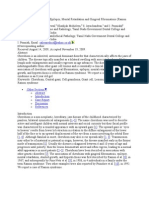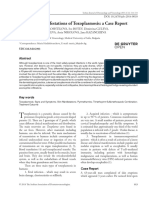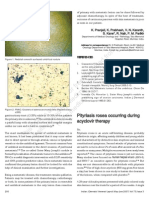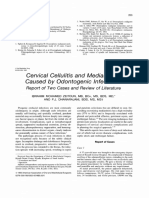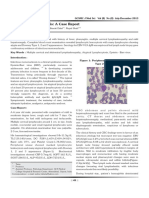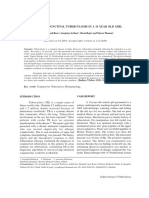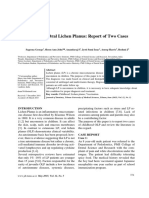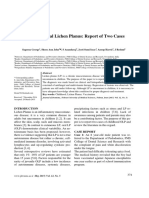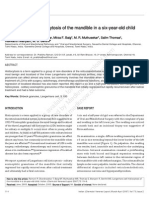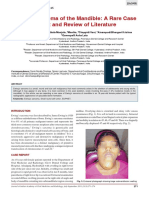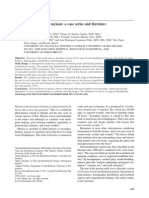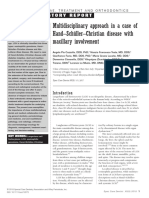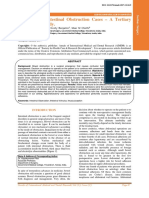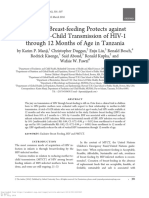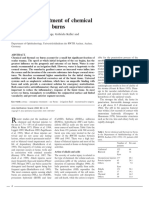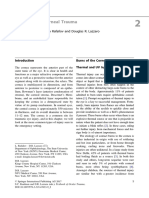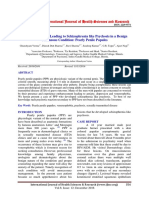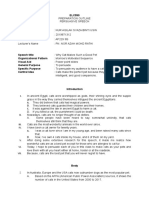Professional Documents
Culture Documents
Atypical Pearly Penile Papules Mimicking Primary Syphilis
Uploaded by
mamal malikaOriginal Title
Copyright
Available Formats
Share this document
Did you find this document useful?
Is this content inappropriate?
Report this DocumentCopyright:
Available Formats
Atypical Pearly Penile Papules Mimicking Primary Syphilis
Uploaded by
mamal malikaCopyright:
Available Formats
Acta Dermatovenerol Croat
2014;22(4):311-312 LETTER TO THE EDITOR
Atypical Pearly Penile Papules Mimicking Primary
Syphilis
Pearly penile papules (PPP) are benign and com- Several modes of therapy are used for treating
mon lesions in the male population. Several terms PPP, including cryotherapy, electrodesiccation, podo-
have been used to describe this entity, including phyllin, curettage, and carbon dioxide laser ablation;
Tyson glands, hirsutoid papillomas, papilla in the co- however, treatment should be reserved for patients
rona glandis, hirsutis papillary corona of the penis, who have cosmetic or psychological concerns from
corona capilliti, and pink pearly papules (1,2). PPP the appearance of this benign entity (2).
commonly develop after puberty and their incidence We report on the case of a 41-year-old Caucasian
decreases with age (1). The prevalence of this condi- man with a history of several months of two non-
tion is estimated to be 14%-48%, the incidence be- painful, smooth papules with a central depression,
ing higher among black males and uncircumcised elevated borders, and annular shape on the dorsal
men (1,3). Their histologic features are characteristic surface of the penis near the neck (Fig. 1). Physical ex-
of angiofibroma and are typically localized to the co- amination of the genitalia was otherwise unremark-
rona and the sulcus of the penis but can also affect able. Before his referral, the lesions had been misdiag-
the shaft (1). PPP may resemble other entities such as nosed as primary syphilis and treated with penicillin
condylomata acuminata, ectopic sebaceous glands, without response.
molluscum contagiosum and lichen nitidus, leading
Because of the uncommon presentation and the
to hazardous and unwarranted treatments (1,2).
patient´s fear of having a sexually transmitted dis-
Pearly penile papules are commonly seen in clin- ease, a skin biopsy was performed. Histologic exami-
ics for sexually transmitted disease (STD) and are a nation revealed dermal ectatic venules embedded in
cause of anxiety in adolescence and young manhood a collagenous stroma with several stellate fibroblasts,
(4). In some studies about PPP, human papillomavirus recovered by a dome shaped acanthotic epidermis
(HPV) was suggested to play a role (5), however, Ho- (Fig. 2). These findings matched the histologic fea-
gewoning et al. showed that there is no association tures of angiofibroma, and the diagnosis of PPP was
between PPP and HPV (3). established. The benign nature of these lesions was
Figure 1. Pearly penile papules. Clinical features: two Figure 2. Pearly penile papules. Histologic features of
smooth annular shaped papules. an angiofibroma (hematoxylin and eosin ×40).
ACTA DERMATOVENEROLOGICA CROATICA 311
Letter to the editor Acta Dermatovenerol Croat
2014;22(4):311-312
explained to the patient and therefore no treatment 7. Vesper JL, Messina J, Glass LF, Fenske NA. Profound
was necessary. proliferating pearly penile papules. Int J Dermatol
PPP may vary in shape, size, and color (1), usu- 1995;34:425-6.
ally range from 1 to 2 mm in width and 1 to 4 mm 8. O’Neil CA, Hansen RC. Pearly penile papules on
in length, and can be acuminate, dome, or annular the shaft. Arch Dermatol 1995;131:491-2.
shaped (6). Their color may be pink, white, yellow- 9. Dourmishev LA, Dourmishev AL. Syphilis: un-
ish, or rarely almost translucent, and they are com- common presentations in adults. Clin Dermatol
monly oriented in a single or double row on the co- 2005;23:555-64.
rona, which may partially or completely encircle the
10. Patel H, Wagner M, Singhal P, Kothari S. Systematic
glans (1). There are reports of profound proliferating
review of the incidence and prevalence of genital
PPP arranged radially from the meatus to the corona,
warts. BMC Infect Dis 2013;13:39.
spreading all over the glans (7), ectopic PPP on the
penile shaft of a young boy without typical lesions on
the corona (6), and typical coronal lesions on the ven- Ana Isabel Gouveia1, João Borges-Costa1,2,3,
tral aspect of the penis in an adult man (8). However, Luis Soares-Almeida1,2
PPP localized exclusively near the neck of the penis
with the abovementioned morphology and without
Clínica Universitária de Dermatologia, Hospital de
1
typical lesions in other localizations in an adult man,
Santa Maria; 2Instituto de Medicina Molecular, Facul-
as in our patient, has not yet been described. This case
dade de Medicina da Universidade de Lisboa; 3Instituto
thus represents an atypical and rare presentation of
de Higiene e Medicina Tropical, Lisbon, Portugal
PPP that could be confused with primary syphilis or
condylomata acuminata.
The clinical manifestations of syphilis, the “great
imitator” of skin diseases, are variable in appearance Corresponding author:
and have been reported for centuries (9). HPV is the Ana Isabel Gouveia Clínica Universitária de
most frequent sexually transmitted viral infection in Dermatologia Hospital de Santa Maria
the world (10) and a common reason to seek medical Av. Professor EGas Miniz
attention in sexually transmitted disease clinics.
1649-035 Lisbon
Physicians should be aware of the different clini-
cal presentations of PPP and when the diagnosis is Portugal
uncertain, a biopsy should be performed. anaisabelgouveia@hotmail.com
Received: February 27, 2014
References Accepted: October 1, 2014
1. Agrawal SK, Bhattacharya SN, Singh N. Pearly pe-
nile papules: a review. Int J Dermatol 2004;43:199-
201.
2. Körber A, Dissemond J. Pearly penile papules.
CMAJ. 2009;181:397.
3. Hogewoning CJ, Bleeker MC, van den Brule AJ, Vo-
orhorst FJ, van Andel RE, Risse EK, et al. Pearly pe-
nile papules: still no reason for uneasiness. J Am
Acad Dermatol 2003;49:50-4.
4. Neinstein LS, Goldenring J. Pink pearly papules:
an epidemiologic study. J Pediatr 1984;105:594-5.
5. Mayeaux EJ Jr, Harper MB, Barksdale W, Pope JB.
Noncervical human papillomavirus genital infec-
tions. Am Fam Physician 1995;52:1137-46,1149-
50.
6. Neri I, Bardazzi F, Raone B, Negosanti M, Patrizi A.
Ectopic pearly penile papules: a paediatric case.
Genitourin Med 1997;73:136.
ACTA DERMATOVENEROLOGICA CROATICA
312
You might also like
- Progress in Liver Diseases: Volume 2From EverandProgress in Liver Diseases: Volume 2Hans PopperNo ratings yet
- Chronic Recurrent Multifocal Osteomyelitis in Association With Pyoderma GangraenosumDocument7 pagesChronic Recurrent Multifocal Osteomyelitis in Association With Pyoderma GangraenosumDha Dina SevofrationNo ratings yet
- Ocular Adnexal and Orbital Amyloidosis: A Case Series and Literature ReviewDocument18 pagesOcular Adnexal and Orbital Amyloidosis: A Case Series and Literature ReviewMariela LezamaNo ratings yet
- Gorlin Syndrom SSDC.Document3 pagesGorlin Syndrom SSDC.HarjotBrarNo ratings yet
- Phleboliths and The Vascular Maxillofacial LesionDocument4 pagesPhleboliths and The Vascular Maxillofacial LesionVinay KumarNo ratings yet
- Papuloerythroderma of Ofuji - A Case ReportDocument4 pagesPapuloerythroderma of Ofuji - A Case ReportLidwina ApyakaNo ratings yet
- Eosinophilic Granuloma of The Mandible in A Four Year Old Boy A Rare Case Report and Review of Literature Joccr 3 1061Document4 pagesEosinophilic Granuloma of The Mandible in A Four Year Old Boy A Rare Case Report and Review of Literature Joccr 3 1061Paolo MaldinicerutiNo ratings yet
- Cherubism Combined With EpilepsyDocument7 pagesCherubism Combined With EpilepsywwhhjNo ratings yet
- Clinical: Peripheral Ossifying Fibroma: A Case ReportDocument4 pagesClinical: Peripheral Ossifying Fibroma: A Case Reportsagarjangam123No ratings yet
- Ocular Histoplasmosis SyndromeDocument17 pagesOcular Histoplasmosis SyndromeDiana PSNo ratings yet
- Wolvius 1996Document3 pagesWolvius 1996pamela queirozNo ratings yet
- Yayli (2013) - NS Resembles KaposiDocument3 pagesYayli (2013) - NS Resembles KaposiIlma ArifaniNo ratings yet
- Giant Condyloma Acuminatum - Two Cases With Microinvasive Foci in OneDocument4 pagesGiant Condyloma Acuminatum - Two Cases With Microinvasive Foci in OnewiraNo ratings yet
- Pemphigus Vulgaris PDFDocument1 pagePemphigus Vulgaris PDFAnonymous PwnuzpY4RNo ratings yet
- 1 s2.0 S0302283822026252 MainDocument6 pages1 s2.0 S0302283822026252 MainjuanmisqjNo ratings yet
- UntitledDocument3 pagesUntitledShintaNo ratings yet
- Bégon 2010Document2 pagesBégon 2010pamela queirozNo ratings yet
- Caz de Toxoplasmoza CutanataDocument7 pagesCaz de Toxoplasmoza Cutanatacatalina criceaNo ratings yet
- Pityriasis Rosea Occurring During Acyclovir TherapyDocument3 pagesPityriasis Rosea Occurring During Acyclovir TherapyFenni OktoberryNo ratings yet
- Oral Hairy Leukoplakia As A Sign of HIV InfectionDocument5 pagesOral Hairy Leukoplakia As A Sign of HIV InfectionFitri AngginiNo ratings yet
- Multiple Bilateral Taurodontism. A Case ReportDocument3 pagesMultiple Bilateral Taurodontism. A Case ReportJing XueNo ratings yet
- Papilloma Skuamosa: Laporan Kasus Dan Tinjauan PustakaDocument4 pagesPapilloma Skuamosa: Laporan Kasus Dan Tinjauan PustakarizkyayuarristaNo ratings yet
- Cervical Cellulitis and Mediastinitis Caused by Odontogenic Infections. Report of Two Cases and Review of LiteratureDocument6 pagesCervical Cellulitis and Mediastinitis Caused by Odontogenic Infections. Report of Two Cases and Review of LiteratureJC QuezadaNo ratings yet
- Infectious Mononucleosis: A Case ReportDocument3 pagesInfectious Mononucleosis: A Case ReportSerghei CojocariNo ratings yet
- EN + EosinofiliaDocument3 pagesEN + EosinofiliaAna Flavia BaptistaNo ratings yet
- Histoid Leprosy: A Case ReportDocument5 pagesHistoid Leprosy: A Case Reportsri karuniaNo ratings yet
- Primary Conjunctival Tuberculosis-2Document3 pagesPrimary Conjunctival Tuberculosis-2puutieNo ratings yet
- Childhood OLPDocument6 pagesChildhood OLPNurul Andika Virginia PutriNo ratings yet
- 6703 23736 1 PBDocument3 pages6703 23736 1 PBReski Harlianty HarliNo ratings yet
- Querubismo Marzo JOMSDocument6 pagesQuerubismo Marzo JOMSJerson Huamán BernalNo ratings yet
- Artigo Psoríase 1Document2 pagesArtigo Psoríase 1Eli MoreiraNo ratings yet
- Articulo 3Document23 pagesArticulo 3Kari SanguilNo ratings yet
- Giant Cell Epulis: Report of 2 Cases.: Oral PathologyDocument11 pagesGiant Cell Epulis: Report of 2 Cases.: Oral PathologyVheen Dee DeeNo ratings yet
- 41 Yugandar EtalDocument4 pages41 Yugandar EtaleditorijmrhsNo ratings yet
- Erosive Lichen Planus: A Case ReportDocument4 pagesErosive Lichen Planus: A Case ReportNuningK93No ratings yet
- Palmoplantar Keratoderma and Edentulous Status: Two Isolated Expressions of Papillon-Lefèvre SyndromeDocument4 pagesPalmoplantar Keratoderma and Edentulous Status: Two Isolated Expressions of Papillon-Lefèvre Syndromeseema sharmaNo ratings yet
- A FurtherDocument5 pagesA FurtherPedroNo ratings yet
- 333 FullDocument6 pages333 FullImara BQNo ratings yet
- Squamous Papilloma On Hard Palate: Case Report and Literature ReviewDocument3 pagesSquamous Papilloma On Hard Palate: Case Report and Literature ReviewadelNo ratings yet
- Oral Findings of Systemic Lupus Erythematosus-A Grand Round CaseDocument5 pagesOral Findings of Systemic Lupus Erythematosus-A Grand Round CaseIntanNo ratings yet
- Content ServerDocument3 pagesContent ServerMario CastroNo ratings yet
- Childhood Oral Lichen Planus: Report of Two CasesDocument5 pagesChildhood Oral Lichen Planus: Report of Two CasesFuad HasanNo ratings yet
- Case Report: Langerhans Cell Histiocytosis of The Mandible in A Six-Year-Old ChildDocument0 pagesCase Report: Langerhans Cell Histiocytosis of The Mandible in A Six-Year-Old ChildElvina Agnestin HarianjaNo ratings yet
- Oral Squamous Papilloma in A Pediatric Patient A Case ReportDocument4 pagesOral Squamous Papilloma in A Pediatric Patient A Case Reportaulia lubisNo ratings yet
- Ewings Sarcoma of The Mandible A Rare Case ReportDocument4 pagesEwings Sarcoma of The Mandible A Rare Case Reportsyed ahmedNo ratings yet
- MIIASEDocument5 pagesMIIASEcha_09No ratings yet
- Pi Is 1991790212001626Document6 pagesPi Is 1991790212001626Lina NiatiNo ratings yet
- Congenital Epulis in A Newborn: A Case Report, Immunoprofiling and Review of LiteratureDocument4 pagesCongenital Epulis in A Newborn: A Case Report, Immunoprofiling and Review of LiteratureanggunNo ratings yet
- Calvarial Tuberculosis: E Ünüvar, F O Guz, B Sadiko Glu, M Sidal, Ü One S and S TetikkurtDocument2 pagesCalvarial Tuberculosis: E Ünüvar, F O Guz, B Sadiko Glu, M Sidal, Ü One S and S Tetikkurtkbianca26No ratings yet
- Saxena 2019Document4 pagesSaxena 2019Fitri Kasmita SariNo ratings yet
- Hypospadias Tulip SignDocument4 pagesHypospadias Tulip Signkomlanihou_890233161No ratings yet
- Pindborg 1967Document6 pagesPindborg 1967DIVYABOSENo ratings yet
- Cazzolla2018 PDFDocument5 pagesCazzolla2018 PDFMarouaBOUFLIJANo ratings yet
- Sarcoidosis (Heerfordt Syndrome) : A Case Report: Tiia Tamme, Edvitar Leibur, Andres KullaDocument4 pagesSarcoidosis (Heerfordt Syndrome) : A Case Report: Tiia Tamme, Edvitar Leibur, Andres KullajaquelineartNo ratings yet
- Rosai Dorfman ChildDocument3 pagesRosai Dorfman ChildElena PoriazovaNo ratings yet
- Laryngeal Syphilis A Case Report PDFDocument4 pagesLaryngeal Syphilis A Case Report PDFfatmiarsih fatmiNo ratings yet
- A Case Report of A 55 Year Old Female With Epulis GranulomatosaDocument3 pagesA Case Report of A 55 Year Old Female With Epulis GranulomatosaIsmail YusufNo ratings yet
- Adult Langerhans Cell Histiocytosis With A Rare BRAF - 2022 - Advances in Oral ADocument3 pagesAdult Langerhans Cell Histiocytosis With A Rare BRAF - 2022 - Advances in Oral Ag.abdulrhmanNo ratings yet
- Dermoskopi 2Document4 pagesDermoskopi 2Eldie RahimNo ratings yet
- Langerhans Cell HistiocytosisDocument4 pagesLangerhans Cell HistiocytosisMércia FonsecaNo ratings yet
- DafpusDocument1 pageDafpusmamal malikaNo ratings yet
- Daftar PustakaDocument1 pageDaftar Pustakamamal malikaNo ratings yet
- Pearly Penile Papules: Effective Therapy With Pulsed Dye LaserDocument3 pagesPearly Penile Papules: Effective Therapy With Pulsed Dye Lasermamal malikaNo ratings yet
- A Pattern of Intestinal Obstruction Cases - A Tertiary Care Centre StudyDocument5 pagesA Pattern of Intestinal Obstruction Cases - A Tertiary Care Centre Studymamal malikaNo ratings yet
- Knowledge Attitudes and Practices of Hiv Positive Breastfeeding Mothers in Prevention of Mother To Child Transmission of Hiv in Ou 2090 7214 1000284Document7 pagesKnowledge Attitudes and Practices of Hiv Positive Breastfeeding Mothers in Prevention of Mother To Child Transmission of Hiv in Ou 2090 7214 1000284mamal malikaNo ratings yet
- DafpusDocument1 pageDafpusmamal malikaNo ratings yet
- JurnalDocument12 pagesJurnalIrara RaNo ratings yet
- Weekly PARTNERDocument64 pagesWeekly PARTNERmamal malikaNo ratings yet
- Journal PediatricDocument17 pagesJournal Pediatricmamal malikaNo ratings yet
- Chronic Suppurative Otitis MediaDocument4 pagesChronic Suppurative Otitis Mediamamal malikaNo ratings yet
- Jurnal IdaDocument9 pagesJurnal IdaSanti NirmawatiNo ratings yet
- Corneal Graft (Keratoplasty) : Oxford Eye HospitalDocument12 pagesCorneal Graft (Keratoplasty) : Oxford Eye Hospitalmamal malikaNo ratings yet
- Journal Breast FeedingDocument7 pagesJournal Breast Feedingmamal malikaNo ratings yet
- Resep Oat PDFDocument4 pagesResep Oat PDFmamal malikaNo ratings yet
- Chronic Suppurative Otitis Media: Jose AcuinDocument20 pagesChronic Suppurative Otitis Media: Jose AcuinHanii HunnNo ratings yet
- Indri 1Document7 pagesIndri 1mamal malikaNo ratings yet
- Chronic Suppurative Otitis Media: Jose AcuinDocument20 pagesChronic Suppurative Otitis Media: Jose AcuinHanii HunnNo ratings yet
- Pearly Penile Papules: Effective Therapy With Pulsed Dye LaserDocument3 pagesPearly Penile Papules: Effective Therapy With Pulsed Dye Lasermamal malikaNo ratings yet
- Osteomyelitis: An Overview of Antimicrobial Therapy. PP 15-22Document2 pagesOsteomyelitis: An Overview of Antimicrobial Therapy. PP 15-22mamal malikaNo ratings yet
- Malika Chronic Suppurative Otitis MediaDocument1 pageMalika Chronic Suppurative Otitis Mediamamal malikaNo ratings yet
- c2Document12 pagesc2mamal malikaNo ratings yet
- Chronic Suppurative Otitis Media: Jose AcuinDocument20 pagesChronic Suppurative Otitis Media: Jose AcuinHanii HunnNo ratings yet
- Diagnosis and Management of Pearly Penile PapulesDocument5 pagesDiagnosis and Management of Pearly Penile Papulesmamal malikaNo ratings yet
- Soap BedahDocument2 pagesSoap Bedahmamal malikaNo ratings yet
- Pearly Penile Papules: Effective Therapy With Pulsed Dye LaserDocument3 pagesPearly Penile Papules: Effective Therapy With Pulsed Dye Lasermamal malikaNo ratings yet
- International Journal of Health Sciences and ResearchDocument4 pagesInternational Journal of Health Sciences and Researchmamal malikaNo ratings yet
- Osteomyelitis: An Overview of Antimicrobial Therapy. PP 15-22Document2 pagesOsteomyelitis: An Overview of Antimicrobial Therapy. PP 15-22mamal malikaNo ratings yet
- Diagnosis and Management of Pearly Penile PapulesDocument5 pagesDiagnosis and Management of Pearly Penile Papulesmamal malikaNo ratings yet
- Which Is The Ideal Treatment For Benign Diffuse and Multinodular Non-Toxic Goiters?Document8 pagesWhich Is The Ideal Treatment For Benign Diffuse and Multinodular Non-Toxic Goiters?mamal malikaNo ratings yet
- PTC HistoryDocument16 pagesPTC HistorySubhi MishraNo ratings yet
- Renal Function TestsDocument23 pagesRenal Function TestsKer YehunNo ratings yet
- Concept of Poultry Insurance Schemes in India - Poultry ShortsDocument12 pagesConcept of Poultry Insurance Schemes in India - Poultry ShortsAbhishek SharmaNo ratings yet
- ELC590 PS OUTLINE Dangers of Cell Phones (030919)Document5 pagesELC590 PS OUTLINE Dangers of Cell Phones (030919)Qila HusinNo ratings yet
- Immunology Syllabus-2015 PDFDocument307 pagesImmunology Syllabus-2015 PDFLorena BravoNo ratings yet
- The Truth About DyslexiaDocument2 pagesThe Truth About DyslexiaLinda BalsigerNo ratings yet
- Case Study (Typhoid Fever)Document2 pagesCase Study (Typhoid Fever)lance rowyNo ratings yet
- The Resilience Workbook Essential Skills To Recover From Stress, Trauma, and Adversity (Glenn R. Schiraldi) (Z-Library)Document306 pagesThe Resilience Workbook Essential Skills To Recover From Stress, Trauma, and Adversity (Glenn R. Schiraldi) (Z-Library)amazzineayoub100% (2)
- NBME 2 Block 1-4Document112 pagesNBME 2 Block 1-4Daniel EspinosaNo ratings yet
- Protoporphyrin Screening: DeficiencyDocument7 pagesProtoporphyrin Screening: DeficiencyFanny Trestanita BahtiarNo ratings yet
- ASCM Web SpleenDocument4 pagesASCM Web Spleennoornoor8No ratings yet
- Mark Scheme (Results) June 2011: GCE Biology (6BI05) Paper 01Document19 pagesMark Scheme (Results) June 2011: GCE Biology (6BI05) Paper 01areyouthere92No ratings yet
- Typology of Nursing Problems FNCPDocument9 pagesTypology of Nursing Problems FNCPPrsnigarbha Dasi D PotianNo ratings yet
- A Study of Normal Hair Growth in The DogDocument9 pagesA Study of Normal Hair Growth in The DogRebeka MenezesNo ratings yet
- PsychequestionsDocument23 pagesPsychequestionsGeorgette Noquera CubayNo ratings yet
- 化學生物學handout Ch. 1Document45 pages化學生物學handout Ch. 1Krisan Mallion LuisNo ratings yet
- Enteral and Parenteral NutritionDocument46 pagesEnteral and Parenteral NutritionbashiruaminuNo ratings yet
- Urologic Principles and Practice 2nd EditionDocument692 pagesUrologic Principles and Practice 2nd EditionRonuve RonuveNo ratings yet
- Klaim Ri Juli 2022Document20 pagesKlaim Ri Juli 2022Fariz A NouvalNo ratings yet
- Manajemen Intoksikasi Dan Keracunan GasDocument27 pagesManajemen Intoksikasi Dan Keracunan GasahmadNo ratings yet
- Tooth Movement (Frontiers of Oral Biology)Document92 pagesTooth Movement (Frontiers of Oral Biology)GABRIELA NIETO GONZALEZNo ratings yet
- Konsep Askep AntenatalDocument16 pagesKonsep Askep AntenatalBakul PariNo ratings yet
- ACV BenefitsDocument3 pagesACV BenefitsfizzyshadowNo ratings yet
- My Coc 123Document47 pagesMy Coc 123Ibsa UsmailNo ratings yet
- Challenges in Obstetric Anesthesia - Elizabeth WongDocument38 pagesChallenges in Obstetric Anesthesia - Elizabeth WongPaulHerreraNo ratings yet
- Bonica Chapter 35 Myofascial PainDocument61 pagesBonica Chapter 35 Myofascial PainiqraNo ratings yet
- Shiatsu MassageDocument13 pagesShiatsu MassageLawrence Cada Nofies100% (1)
- OBGYN NotesDocument29 pagesOBGYN NotesavavNo ratings yet
- Quiz EmbryologyDocument41 pagesQuiz EmbryologyMedShare90% (67)
- Pineapple Jai PrakashDocument61 pagesPineapple Jai PrakashJai Prakash100% (1)







